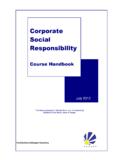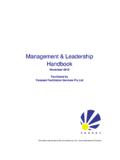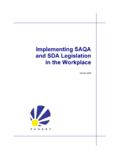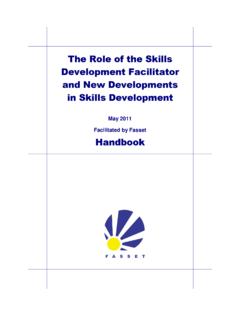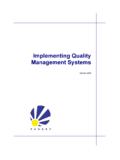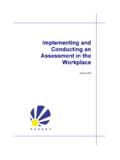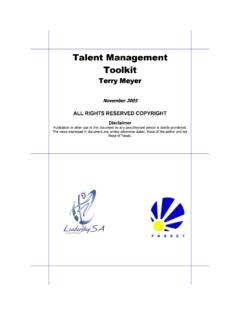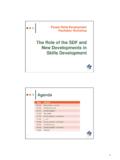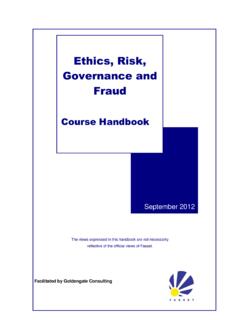Transcription of Scarce Skills Guideline 2015/2016 - Home Page - …
1 Scarce Skills Guideline 2015 / 2016 Revised: 18 November 2015 Prepared by Fasset Research Department Scarce Skills Guideline 2015 / 2016 Updated: 18 November 2015 -2- Scarce Skills Guideline 2015 / 2016 TABLE OF CONTENTS 1. INTRODUCTION .. 6 2. WHAT IS FASSET .. 6 3. FASSET S VISION AND MISSION .. 6 4. PROFILE OF THE FASSET SECTOR .. 7 Subsectors .. 7 Organisations .. 7 Employment Profile .. 8 Transformation in the Fasset Sector .. 8 8 Foreign Nationals .. 9 Age .. 9 Disability .. 9 HIV/ aids Awareness .. 9 5. Scarce Skills .. 10 6. THE DEVELOPMENT OF NEW ENTRANTS INTO THE MARKET .. 11 7. GROWTH IN DEMAND .. 12 Growth in Supply .. 13 Formation of New Skills for the 14 8.
2 CURRENT CRITICAL Skills .. 25 9. A NATIONAL PERSPECTIVE ON Scarce Skills .. 25 10. INTERNATIONAL PERSPECTIVE ON Scarce Skills .. 26 11. ADDRESSING Scarce Skills WITH LEARNERSHIPS .. 28 12. CURRENT Scarce Skills AND THE STATE OF THE SECTOR .. 30 13. CONCLUSION .. 31 School and Further Education and Training .. 31 Further Education and Training (FET) .. 31 Tertiary Education .. 31 Professional .. 31 Bridging Skills .. 31 14. SOURCES .. 32 TABLE OF TABLES Table 1: Top 10 Scarce Skills in demand for 2015 /16 .. 11 Table 2: Top 10 Scarce Skills in demand for 2013/14 and 2014/15 .. 12 Table 3: Managerial occupations in which employers experienced Skills shortages for 2013/2014, 2014/ 2015 & 2015 / 2016 .
3 14 Table 4: Professional occupations in which employers experienced Skills shortages for 2013/2014, 2014/ 2015 & 2015 / 2016 .. 15 Scarce Skills Guideline 2015 / 2016 Updated: 18 November 2015 -3- Table 5: Technician and associate professional occupations in which employers experienced Skills shortages for 2013/2014, 2014/ 2015 & 2015 / 2016 .. 16 Table 6: Clerical support occupations in which employers experienced Skills shortages for 2013/2014, 2014/ 2015 & 2015 / 2016 .. 17 Table 7: Top 10 Scarce Skills occupations in the Fasset Sector for 2013, 2014 & 2015 .. 18 Table 8: Scarce Skills in the Fasset Sector .. 19 Table 9: Learnerships registered with Fasset (November 2015 ) .. 28 Scarce Skills Guideline 2015 / 2016 Updated.
4 18 November 2015 -4- ACRONYMS Abbreviation Definition AA Affirmative Action aids acquired immune deficiency syndrome APEC Asian Pacific Economic Cooperation ATR Annual Training Reports BBBEE Broad-based Black Economic Empowerment BEE Black Economic Empowerment CA Chartered Accountants CEO Chief Executive Officer CESM Classification of Educational Subject Matter CHE Council on Higher Education CPD Continuous Professional Development CTA Certificate in the Theory of Accounting DBE Department of Basic Education DHET Department of Higher Education and Training EA External Auditor EE Employment Equity EEA Employment Equity Act No 55 of 1998 Fasset Finance and Accounting Services Sector Education and Training Authority FET Further Education and Training FETMIS Further Education Management Information System FIA Financial Investment Advisor HEMIS Higher Education Management Information System HET Higher Education and Training HIV Human Immunodeficiency Virus ICB Institute for Certified Bookkeepers ILO International Labour Organisation LCG Learnership Cash Grant LL Lifelong Learning M & E Monitoring and Evaluation NATED National Programmes NCV National Certificate (Vocational)
5 NLP Non Levy Payer NQF National Qualifications Framework NSC National Senior Certificate NSDS National Skills Development Strategy NSF National Skills Fund NSFAS National Student Financial Aid Scheme Scarce Skills Guideline 2015 / 2016 Updated: 18 November 2015 -5- Abbreviation Definition OFO Organising Framework for Occupations PIVOTAL Professional, Vocational, Technical and Academic Learning PMG Parliamentary Monitoring Group QCTO Quality Council for Trades and Occupations RD Research Director RO Research Officer SAICA South African Institute of Chartered Accountants SAJHRD South African Journal of Human Resources Development SAQA South African Qualification Authority SARS South African Revenue Service SCG Strategic Cash Grant SDA Skills Development Act 97 of 1998 SDL Skills Development Levy SDLA Skills Development Levy Act 9 of 1999 SETA Sector Education and Training Authority SSP Sector Skills Plan TVET Technical Vocational Education and Training UoT University of Technology USA United States of America VET Vocational Education and Training WIL Work
6 Integrated Learning WSP Workplace Skills Plan Scarce Skills Guideline 2015 / 2016 Updated: 18 November 2015 -6- 1. INTRODUCTION This annually distributed guide is aimed at those who need to understand and identify Scarce Skills within the Fasset sector. This guide will be useful to all Fasset stakeholders who are in-volved in Skills development initiatives within the sector. Fasset key stakeholders include em-ployers, educationalists, learners, parents, policy-makers, education and training providers. This guide is the ninth, in a series of annual publications in the Fasset Scarce Skills Guideline series. The document describes Skills shortages of financial and accounting professionals in and outside the Fasset sector, especially within the Black African South African and disabled popula-tion groups.
7 The Fasset interventions funded reflect the Seta s strategic goal of addressing Skills shortages, and the commitment of the sector to Skills development and transformation. To ensure a healthy and thriving economy, Skills shortages must be addressed because Skills development is a catalyst to a productive and wealthy nation. 2. WHAT IS FASSET Fasset is one of the 21 Sector Education and Training Authorities (SETAs) established in terms of the Skills Development Act 97 of 1998. One of the central aims of the legislation is to encour-age South African employers to train their employees. Employers can then recover a Skills De-velopment Levy (SDL) (paid in terms of the Skills Development Levies Act (SDLA) 9 of 1999) via grants claimed from their Seta.
8 The mandate of Fasset is to transform the finance and accounting sector by facilitating Skills de-velopment, prioritising previously disadvantaged population groups and in the process, reducing Skills shortages in the sector. Each Seta has a Board that decides on how such Skills shortages are to be addressed and which interventions are to be prioritised. Fasset is the Finance and Accounting Sector Education Training Authority. All relevant Fasset industries are represented on the Fasset Board, which is guided in its strategic decision-making by the vision and mission of the Seta. 3. FASSET S VISION AND MISSION Fasset s vision is: To facilitate the achievement of world-class finance and accountancy skills1 1 By the Fasset Board in July 2015 .
9 Scarce Skills Guideline 2015 / 2016 Updated: 18 November 2015 -7- Fasset s mission is: Increase the flow of new finance and accountancy entrants into employment Develop and grow the Skills required in the sector Facilitate transformation of the finance and accountancy sector 4. PROFILE OF THE FASSET SECTOR Subsectors The Fasset sector consists of organisations categorised into sub-sectors as follows: Investment Entities and Trusts and Company Secretary Services Stockbroking and Financial Markets Development Organisations Accounting, Bookkeeping, Auditing and Tax Services Activities Auxiliary to Financial Intermediation Business and Management Consulting Services, and South African Revenue Services (SARS) and relevant Government Departments Organisations Based on the Fasset Sector Skills Plan (SSP) for the 2016 /2017 period, 5 482 organisations paid their Skills development levies in the 2014/ 2015 financial year as compared to the 5 255 organi-sations in the 2013/2014 financial year.
10 A further 262 levy-exempt organisations had registered on Fasset s system. In addition to these, there may be many sole proprietorships or profession-als with very small (often one-person) practices that are not known to the SETA as they have not registered with Fasset as a Non Levy Payer (NLP). NLP organisations have an annual payroll of less than R 500,000 per annum. The vast majority of organisations in the Fasset sector are very small. The 2012 Sector Survey showed that more than half (54%) employ fewer than ten people. A further 23% employ between 10 and 19 people and 15% have between 20 and 49 employees. This means that 92% of the organisations in the sector fall within the category that is generally known as small organisa-tions.
